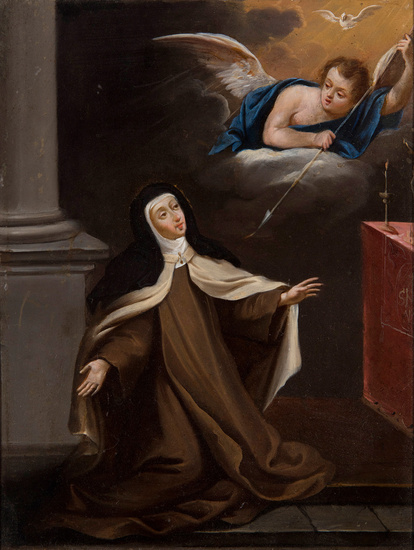Escuela española; S. XVII
Spanish school; mid-17th century.
"The Transverberation of Saint Teresa of Jesus".
Oil on copper.
Measurements: 21,5 x 16,5 cm; 27 x 21,5 cm (frame).
In a sober interior, the saint is disposed with open arms and serene face, before the presence of an angel who carries an arrow, directed directly to the heart. The action represents the transverberation of Saint Teresa of Jesus, a mystical and complete union between the divinity and the nun.
Teresa de Cepeda y Ahumada, better known by the name of Saint Teresa of Jesus or simply Saint Teresa of Avila (Avila, 1515 - Alba de Tormes, 1582) was a Spanish nun, doctor of the Catholic Church, mystic and writer. Together with St. John of the Cross she introduced the great Carmelite reform, and her writings are a model in the ways of prayer and perfection. St. Teresa is undoubtedly one of the greatest and most admirable women in history. At the age of seven she already had a great predilection for reading the lives of the saints. Her brother Rodrigo was almost the same age, so they used to play together. The two children, impressed by the thought of eternity, admired the victories of the saints in conquering eternal glory, so they resolved to set out for the country of the Moors in the hope of dying for the faith and thus becoming martyrs. They set out from their home, but on the way they were picked up by one of their uncles, who returned them to their mother. In view of the failure of their plans, Teresa and Rodrigo decided to live as hermits in their own house and began to build a cell in the garden, although they never finished it. Teresa loved solitude from then on. In her room she had a picture of the Saviour talking to the Samaritan woman, and she used to repeat in front of it: "Lord, give me a drink so that I may never thirst again". During her adolescence, Teresa fell ill, and during her convalescence she decided to devote herself entirely to religious life. She entered the convent of the Incarnation in Avila at the age of eighteen and, after her health deteriorated, was cured, according to her, by Saint Joseph. Three years later, as she recounts in her writings, Jesus Christ appeared to her in the parlour with an angry countenance, reprimanding her for her familiar dealings with the laity, which had caused her to neglect prayer. In 1558 he had his first rapture and vision of hell, and from then on he enjoyed great heavenly favours such as the vision of the risen Jesus. All these mystical experiences were reflected in his lyrical-religious poetry.
View it on
Sale price
Estimate
Time, Location
Auction House
Spanish school; mid-17th century.
"The Transverberation of Saint Teresa of Jesus".
Oil on copper.
Measurements: 21,5 x 16,5 cm; 27 x 21,5 cm (frame).
In a sober interior, the saint is disposed with open arms and serene face, before the presence of an angel who carries an arrow, directed directly to the heart. The action represents the transverberation of Saint Teresa of Jesus, a mystical and complete union between the divinity and the nun.
Teresa de Cepeda y Ahumada, better known by the name of Saint Teresa of Jesus or simply Saint Teresa of Avila (Avila, 1515 - Alba de Tormes, 1582) was a Spanish nun, doctor of the Catholic Church, mystic and writer. Together with St. John of the Cross she introduced the great Carmelite reform, and her writings are a model in the ways of prayer and perfection. St. Teresa is undoubtedly one of the greatest and most admirable women in history. At the age of seven she already had a great predilection for reading the lives of the saints. Her brother Rodrigo was almost the same age, so they used to play together. The two children, impressed by the thought of eternity, admired the victories of the saints in conquering eternal glory, so they resolved to set out for the country of the Moors in the hope of dying for the faith and thus becoming martyrs. They set out from their home, but on the way they were picked up by one of their uncles, who returned them to their mother. In view of the failure of their plans, Teresa and Rodrigo decided to live as hermits in their own house and began to build a cell in the garden, although they never finished it. Teresa loved solitude from then on. In her room she had a picture of the Saviour talking to the Samaritan woman, and she used to repeat in front of it: "Lord, give me a drink so that I may never thirst again". During her adolescence, Teresa fell ill, and during her convalescence she decided to devote herself entirely to religious life. She entered the convent of the Incarnation in Avila at the age of eighteen and, after her health deteriorated, was cured, according to her, by Saint Joseph. Three years later, as she recounts in her writings, Jesus Christ appeared to her in the parlour with an angry countenance, reprimanding her for her familiar dealings with the laity, which had caused her to neglect prayer. In 1558 he had his first rapture and vision of hell, and from then on he enjoyed great heavenly favours such as the vision of the risen Jesus. All these mystical experiences were reflected in his lyrical-religious poetry.



